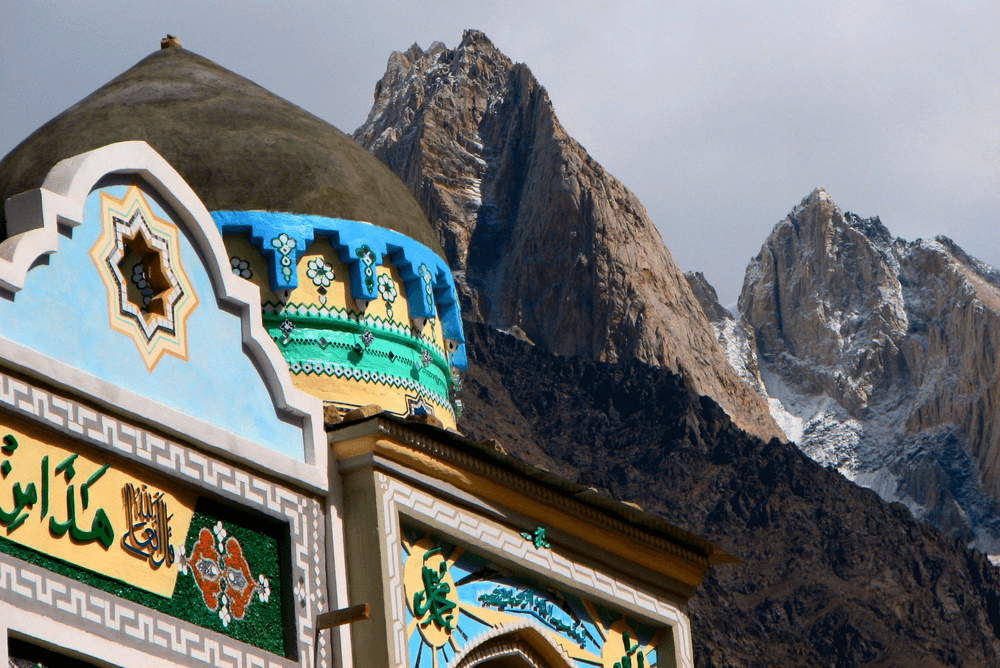

The Zarafshan is one of the great rivers of Central Asia. Its name translates as "The Strewer of Gold", and the name under which it was known to the Ancient Greeks - the Polytimetus, or "Abundant in Wealth" - reflects its nature throughout history. It has been the nourisher of the great cities of Samarqand and Bukhara, and the civilisations centred there. These cities and those all along the river have always relied on the arriqs (irrigation canals) to enable the production of a rich variety of crops. The regular flooding in the lower reaches provided the silt to form large areas of fertile fields. It has also been a gold bearing river - hence the name - and this has added to its economic importance. It flows in a remarkably straight line from its headwaters fed by the glaciers of both the Zarafshan and Turkestan ranges. Joined by numerous other tributaries, it flows to Bukhara and though it once joined the Oxus (Amu Darya), now it drains away into the deserts.
The Zarafshan River at the bottom of the valley that bears its name irrigates an emerald-green strip of land, the vibrant colour of which stands in stark contrast to the crumbling, brownish-grey scree of the steep mountain slopes either side. Along with the parallel Yagnob Valley, the 200km (125-mile) Zarafshan Valley is a popular area for trekking, and within easy reach of Dushanbe, Khujand and Penjikent.
The major appeal of the Zarafshan Valley is its magnificent landscape: deep gorges and cliffs, the Zarafshan River itself, groves of fruit and nut trees, and ribbons of irrigated land. The valley has a number of fortifications; its inhabitants have constantly warred with one another or needed to see off invaders. The ruined tower of Hazrati Burq in Rarz dates from the 10th century and was once part of a far largely military complext.
Hazarti burgh
- PriceUSD PriceQuantityExpirationFrom
- PriceUSD PriceQuantityFloor DifferenceExpirationFrom
Hazarti burgh

- PriceUSD PriceQuantityExpirationFrom
- PriceUSD PriceQuantityFloor DifferenceExpirationFrom
The Zarafshan is one of the great rivers of Central Asia. Its name translates as "The Strewer of Gold", and the name under which it was known to the Ancient Greeks - the Polytimetus, or "Abundant in Wealth" - reflects its nature throughout history. It has been the nourisher of the great cities of Samarqand and Bukhara, and the civilisations centred there. These cities and those all along the river have always relied on the arriqs (irrigation canals) to enable the production of a rich variety of crops. The regular flooding in the lower reaches provided the silt to form large areas of fertile fields. It has also been a gold bearing river - hence the name - and this has added to its economic importance. It flows in a remarkably straight line from its headwaters fed by the glaciers of both the Zarafshan and Turkestan ranges. Joined by numerous other tributaries, it flows to Bukhara and though it once joined the Oxus (Amu Darya), now it drains away into the deserts.
The Zarafshan River at the bottom of the valley that bears its name irrigates an emerald-green strip of land, the vibrant colour of which stands in stark contrast to the crumbling, brownish-grey scree of the steep mountain slopes either side. Along with the parallel Yagnob Valley, the 200km (125-mile) Zarafshan Valley is a popular area for trekking, and within easy reach of Dushanbe, Khujand and Penjikent.
The major appeal of the Zarafshan Valley is its magnificent landscape: deep gorges and cliffs, the Zarafshan River itself, groves of fruit and nut trees, and ribbons of irrigated land. The valley has a number of fortifications; its inhabitants have constantly warred with one another or needed to see off invaders. The ruined tower of Hazrati Burq in Rarz dates from the 10th century and was once part of a far largely military complext.